 |
|
|
| (Information by Peter Kessler, with additional information from Funk & Wagnalls New Encyclopaedia, 1985 Edition (Revised 1993), from La Ciudadela de Barcelona: Cataluña vindicada, Lluís Cutchet (in Spanish), from Los Condes de Barcelona Vindicados, y Cronología y Genealogía de los Reyes de España considerados como Soberianos Independientes de su Marca. Tomo I: abraza los siete primeros, desde el año 874 al 1035, Prosper de Bofarull (in Spanish, 1836, reprinted 1990), and from External Links: Encyclopaedia.com, and Lleida Tourism, and Enciclopèdia Catalana, SAU, and Representació de SE Copríncep Francès (in French and Catalan), and Sarkozy threatens to renounce Andorra title (EUObserver), and La aprobación de la ley del Aborto en Andorra podría llevar a Vives a Barcelona (Periodista Digital, in Spanish), and Élysée.) |
|
|
| 778?/785 |
Tradition asserts that the Frankish King Charlemagne grants the Andorran people a charter in return for their help in fighting the Iberian Moors of the Islamic empire. Charlemagne is known to conduct a campaign against Islamic Iberia in 778, so this could be the point at which Andorra provides support. 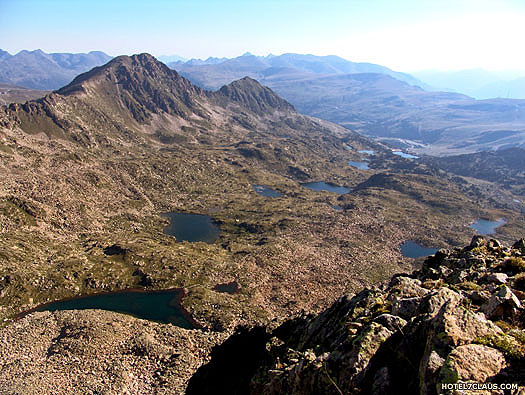 Andorra's mountainous landscape offers a very mixed selection of terrain, from lush valleys to high Pyrenean peaks and the Circ del Pessons shown here, a natural amphitheatre in the area of Grau Roig Andorra's mountainous landscape offers a very mixed selection of terrain, from lush valleys to high Pyrenean peaks and the Circ del Pessons shown here, a natural amphitheatre in the area of Grau Roig |
|
| Confirmation seems to come around 785 when the county of Urgel is created as a division of the march (border area) of Toulouse following territorial seizures from the Moors by the Franks. The king's son, Louis I, king of Aquitaine from 781 (and ruler of the Carolingian empire in 814-840), reputedly confirms the charter, and the creation of the Cathedral of Urgel in 839 does show increasing Christian support for this region. It is generally agreed that Charles 'the Bald' (840-877), son of Louis and first of the Carolingian kings of the [Western Franks](FranceFranks.htm#Western Franks), appoints the count of Urgel as overlord of Andorra, giving him the right to collect the imperial tribute. A Visigothic noble by the name of Borrell is the first count of Urgel, Cerdanya, and Osona (the latter from 799). |
|
|
| c.798 - 820 |
Borrell |
Appointed by Charles 'the Bald' of the [Western Franks](FranceFranks.htm#Western Franks). |
| 799 - 801 |
Having been appointed count of the newly captured territories of Urgel and Cerdanya, Borrell is an important part of the conquest of Osona in 799 and Barcelona in 801. The latter victory follows a siege of the city. He is awarded the county of Osona, possibly in thanks for his contribution towards the reconquest of occupied Iberia and the extension of Aquitaine's Marca Hispania, or Spanish March (a march being a Germanic word for borderlands). |
|
| 820 |
Following Borrell's death, Osona is granted to Rampon, count of Barcelona, while Urgel and Cerdanya pass to the Basque noble, Aznar I Galíndez of Aragon, following his overthrow and exile from that county. 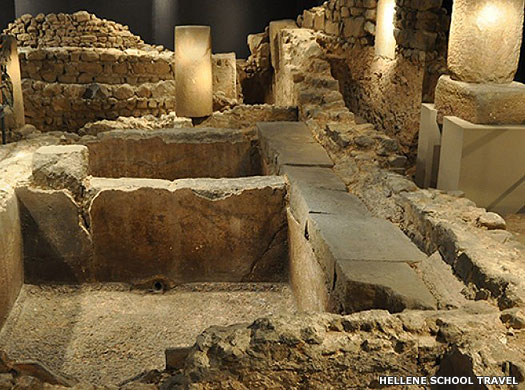 Founded as the Roman colony of Barcino, between 15-10 BC by Emperor Augustus, the city of Barcelona became central to the medieval county of Barcelona and resistance against the Islamic invasion of Iberia Founded as the Roman colony of Barcino, between 15-10 BC by Emperor Augustus, the city of Barcelona became central to the medieval county of Barcelona and resistance against the Islamic invasion of Iberia |
|
| 820 - 824 |
Aznar I Galíndez |
Count of Aragon. Exiled and succeeded Borrell. Died 839. |
| 824 - 834 |
Galindo I Aznárez |
Son. Dispossessed. Reclaimed Aragon in 844. Died 867. |
| 834 - 838 |
Sunifred, son-in-law of Belló, count of Carcassonne, is granted Urgel and Cerdanya by Louis 'the Pious', who has progressed from his early role as king of Aquitaine to ruling the Frankish empire. Sunifred conquers Cerdanya in 835 and Urgel in 838 so that Galindo is dispossessed of his holdings. Even so, he soon goes on to reclaim Aragon for himself. |
|
| 834 - 848 |
Sunifred I |
Count of Barcelona (844), Girona-Osona, & Urgel-Cerdanya. |
| 840 - 843 |
Before his death, Louis 'the Pious' of the Franks proclaims that his eldest son, Lothar, will be sole beneficiary of the imperial dignity and sole inheritor of the empire. The new idea provokes rebellions and rivalries between all four of Louis' sons which last until after the king's death. (One of the sons, Pepin I of Aquitaine, has already predeceased his father.) Lothar initially claims overlordship over all three regions and Louis and Charles have to go to war to convince him to relent. The counties of the Spanish March all take sides during this period. The powerful Bernard of Septimania, count of Barcelona (along with a large number of other marches and counties, including Agde, Béziers, Girona, Melgueil, Narbonne, Nîmes, Septimania, and Toulouse, capital of Aquitaine) sides with Pepin II of Aquitaine. 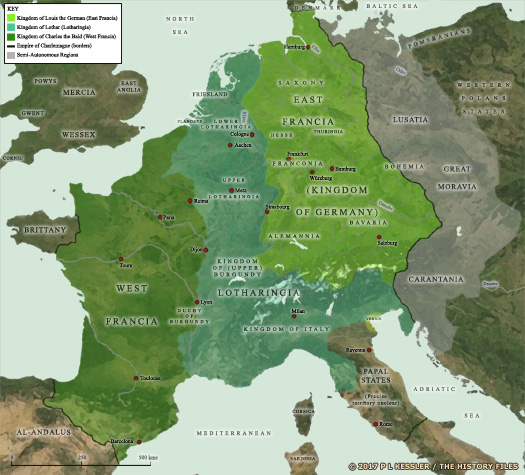 King Louis 'the Pious' of the Frankish empire attempted to leave the empire intact for his eldest son, Lothar, but the others rebelled at the idea. The treaty of Verdun in AD 843 confirmed the official division of the empire between Charlemagne's three surviving grandsons (click or tap on map to view full sized) King Louis 'the Pious' of the Frankish empire attempted to leave the empire intact for his eldest son, Lothar, but the others rebelled at the idea. The treaty of Verdun in AD 843 confirmed the official division of the empire between Charlemagne's three surviving grandsons (click or tap on map to view full sized) |
|
| Opposing them in favour of Charles are Sunifred, count of Urgel (and Andorra) and Cerdanya, his brother Sunyer I, count of Empúries, their sons (who collectively are sometimes referred to as the Bellonid dynasty or the Bellonids), Ricwin, count of Nantes (killed in battle in 841), and Lambert II, also later count of Nantes. Lothar does relent in 843, and the Treaty of Verdun confirms the official division of the empire between Charlemagne's surviving three grandsons, with rule over the empire as a whole being nominal. |
|
|
| 841 - 844 |
Taking advantage of the chaos in the Frankish empire, the Umayyads invade Barcelona and penetrate Cerdanya as they attack Narbonne. Sunifred, count of Urgel and Cerdanya, stops the invasion dead in its tracks. When, in 844, Charles 'the Bald' captures Toulouse and Aquitaine from Pepin II, he has Bernard of Septimania executed and grants Barcelona and Girona - and also the march territory of Gothia - to Sunifred. |
|
| 848 |
William of Septimania, son of the executed Bernard, had risen against Charles 'the Bald' in 844, but has largely been unable to reclaim his father's lands until now. William is granted Toulouse and Empúries by Pepin II the rival king of Aquitaine, and he quickly removes both brothers, Sunifred in Barcelona and Sunyer in Empúries, although the former is known to die of natural causes. 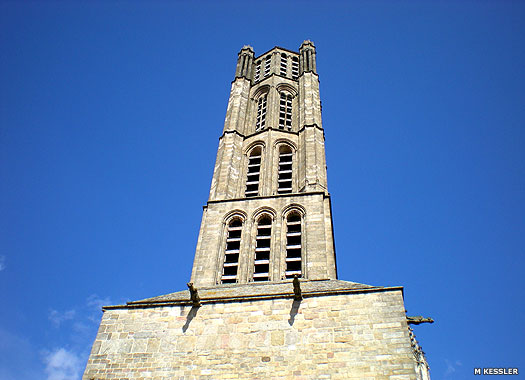 Limoges remained the capital of the duchy of Aquitaine, and the Roman Catholic Cathedral of Saint-Etienne remained the city's religious seat Limoges remained the capital of the duchy of Aquitaine, and the Roman Catholic Cathedral of Saint-Etienne remained the city's religious seat |
|
| 848 - 870 |
Solomon |
Appointed count of Urgel-Cerdanya. Died between 868-870. |
| 870 - 897 |
Wilfred the Hairy |
Son of Sunifred. Count of Barcelona and others. |
| 898 - 948 |
Sunifred II |
Son. |
| 948 - 966 |
Miró de Barcelona |
Co-ruler of Barcelona with Borrell II. |
| c.950 |
The Catalan House of Caboet occupies the Cabó and Saint John valleys (along modern Andorra's border), with their power originating in the former. They emerge into history around this time as loyal subjects of the bishops of Urgel. The bishopric itself has existed since the death of St Just d'Urgel around 546, under the jurisdiction of Tarragona. |
|
| 966 - 992 |
Borrell II |
Count of Barcelona, Girona, & Osona. |
| 988 |
Borrell II, count of Barcelona, Girona, Ausona (from 940), and Urgel (from 948), grants the Andorran valleys to the diocese of Urgel in exchange for land in Cerdanya. |
|
| fl c.1010 |
Isarn Caboet |
Lady of Caboet. |
| ? - 1095 |
Guitard Caboet |
Son. Lord of Caboet. Gained co-control of Andorra (1095)? |
| 1095 |
The bishop of Urgel is aware that the current count of Urgel desires the return of Andorra to his control, so support and protection are requested of the lord of Caboet. The bishop and the lord sign and seal a declaration of their co-sovereignty over Andorra (it is unclear whether this lord is Guitard or his successor, Guillem Guitard). 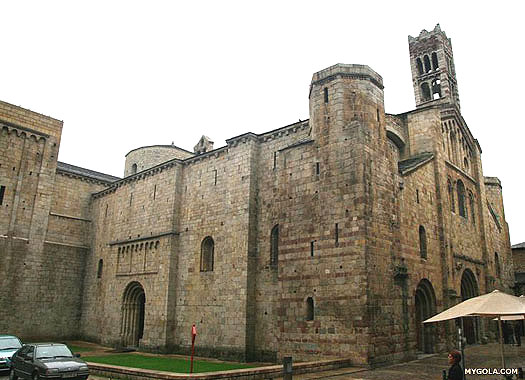 The bishopric of Urgel gained a diocesan seat in 1116, in the form of the Cathedral of Santa Maria d'Urgel, in Seu d'Urgel, although the diocese itself existed at least as early as the sixth century AD The bishopric of Urgel gained a diocesan seat in 1116, in the form of the Cathedral of Santa Maria d'Urgel, in Seu d'Urgel, although the diocese itself existed at least as early as the sixth century AD |
|
| 1095 - ? |
Guillem Guitard Caboet |
Son. Lord of Caboet. Gained or inherited Andorra. |
| ? |
Miró Guitard Caboet |
Son. Lord of Caboet. |
| 1114 - 1150 |
Peter I |
Viscount of Alt Urgel. Gained Cerdanya (1126). Viscount (1127). |
| 1126 - 1127 |
Peter I, viscount of Urgel is the first to assume the title viscount of Castellbò, following his marriage to Sybil, heir to the viscounty of Cerdanya. He and his successors are shown here in green to avoid confusion with the House of Caboet. |
|
| ? |
Ramon Caboet |
Son of Miró. Lord of Caboet. |
| ? - 1170 |
Arnau Caboet |
Son. Lord of Caboet. Died without male issue. |
| 1150 - 1185 |
Ramon II Castellbò |
Son of Peter I. Viscount of Castellbò (Alt Urgell & Cerdanya). |
| 1159 |
The oath of 1095 between the Caboet and the bishopric of Urgel is now confirmed by a treaty between Viscount Arnau and Bernat Sanç (Sancho), bishop of Urgel. This treaty also stipulates that although the House of Caboet still exercises co-sovereignty, it is not able to exercise rights over politicians, the military, or judicial matters. |
|
| 1180 |
The widowed Arnalda, daughter of Arnau of Caboet, has remained under the protection of the bishop of Urgel following the death of her father and her first husband, Bertran de Tarascon. Now she marries the future Viscount Arnau of Castellbò ('the castle, stronghold'), joining together that title with Cerdanya and making the viscount's descendants the successors of the House of Caboet. Arnalda dies in 1201 or 1203. 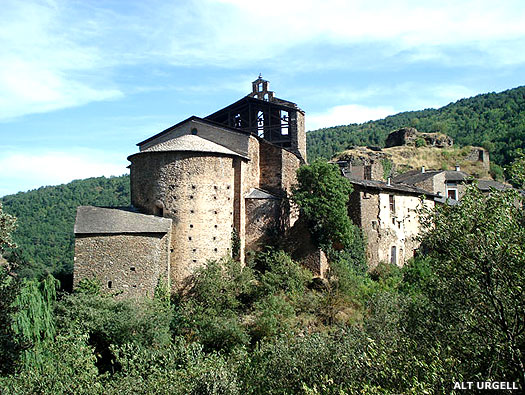 The great temple which is located at the foot of the tower which forms part of the ancient castle of Castellbò is of an uncertain age, supposedly with Roman origins The great temple which is located at the foot of the tower which forms part of the ancient castle of Castellbò is of an uncertain age, supposedly with Roman origins |
|
| 1185 - 1226 |
Arnau Castellbò |
Son. Viscount of Castellbò. Married Arnalda Caboet. |
| 1186 |
Concerned that the viscounts of Castellbò may be tempted to exercise too much power in Andorra, the bishop of Urgel ensures that Arnau Castellbò is not recognised by the Andorrans as their lord without his consent. |
|
| 1226 |
The daughter of Arnalda and her husband, the viscount of Castellbò, is Ermessenda. She now marries Roger Bernat II, the count of Foix in south-central France. They become Roger Bernat II and Ermessenda I, counts of Foix, viscounts of Castellbò and Cerdanya, and co-sovereigns of Andorra (still shared with the bishop of Urgel). |
|
| 1226 - 1230 |
Ermessenda Castellbò |
Daughter. Viscountess of Castellbò. Married Roger Bernat II. |
| 1230 - 1240 |
Roger Bernat I (II of Foix) |
Husband. Count of Foix. Administered Andorra from 1230. |
| 1240 - 1265 |
Roger (IV of Foix) |
Administered Andorra from 1240. |
| 1265 - 1278 |
Roger Bernat II (III of Foix) |
Son? |
| 1278 |
Quarrels between the Spanish bishop of Urgel and the French counts over rights in Andorra leads now to their adoption of a paéage, a feudal institution which recognises the equal rights of two lords to a seigniorage. The Treaty of Joint Suzerainty between the bishop of Urgel and the count of Foix will see them acting as co-princes. The numbering for the counts of Foix now ignores Castellbò's numbering, while the naming assumes a more Anglicised format thanks to the records being used to source the information.  A medieval map of the city of Paris in the tenth century AD, under the rule of Hugh Capet. By this time Paris had declined from its two periods of greatness under the Romans and the Merovingians, but the map clearly shows the importance of the island at the city's heart A medieval map of the city of Paris in the tenth century AD, under the rule of Hugh Capet. By this time Paris had declined from its two periods of greatness under the Romans and the Merovingians, but the map clearly shows the importance of the island at the city's heart |
|
| Bishops of Urgel |
Counts of Foix |
|
| 1278 - 1293 |
Pedro d'Urg / d'Urtx |
Bishop of Urgel since 1269. |
| 1278 - 1302 |
Roger Bernard III |
Count of Foix and viscount of Castellbò. Killed. |
| 1290 - 1302 |
The wife of Roger Bernard inherits the viscounty of Bearn. In 1295 he is appointed governor of Gascony and his first act is to return the two castles which he had earlier seized. He is mortally wounded in 1302 fighting the Catalans, and dies in Tarascon (Tarascó). His body is placed in the Cistercian Abbey of Bolbona. |
|
| 1295 - 1308 |
Guillem de Montcada |
Bishop of Urgel. |
| 1302 - 1315 |
Gaston I |
Son of Roger. Count of Foix and viscount of Castellbò. |
| 1309 - 1326 |
Ramón Trebaylla |
Bishop of Urgel. |
| 1315 |
Gaston II of Foix and IX of Bearn inherits these titles from his father in 1308, but the viscounty of Castellbò passes to his brother, Roger Bernat (Bernard). During his lifetime he gains other titles in the form of viscount of Lautrec, Marsan, and Gabardà, lord of Andorra (in 1315), and also Donasà. 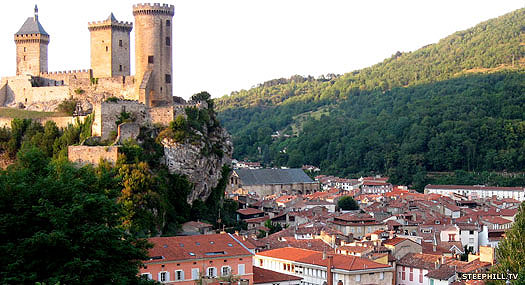 The county of Foix was situated in south-eastern France, touching the Pyrenees at its lowest point and providing a western neighbour to the important regional centre of Narbonne The county of Foix was situated in south-eastern France, touching the Pyrenees at its lowest point and providing a western neighbour to the important regional centre of Narbonne |
|
| 1315 - 1343 |
Gaston II |
Son of Gaston. Count of Foix. Died 1343, buried Bolbona Abbey. |
| 1326 - 1341 |
Arnau de Llordà |
Bishop of Urgel. |
| 1341 - 1347 |
Pere de Narbona |
Bishop of Urgel. |
| 1343 - 1391 |
Gaston III Phoebus |
Son of Gaston. Count of Foix. Failed to produce male heir. |
| 1348 - 1351 |
Niccolo Capocci |
Bishop of Urgel. |
| 1351 - 1361 |
Hug Desbac |
Bishop of Urgel. |
| 1362 - 1364 |
Guillem Arnau de Patau |
Bishop of Urgel. |
| 1365 - 1370 |
Pero de Luna |
Bishop of Urgel. |
| 1371 - 1388 |
Berenguer D'Erill |
Bishop of Urgel. |
| 1388 - 1415 |
Galceran de Vilanova |
Bishop of Urgel. |
| 1391 |
With Gaston's failure to produce a recognisable heir for the county of Foix, the title passes to his cousin Matthew. As viscount of Castellbò since 1381, Matthew is able to reunify the two titles. |
|
| 1391 - 1396 |
Matthew |
Cousin of Gaston. Count of Foix. Viscount of Castellbò. |
| 1396 |
Matthew invades Catalonia to further his claim to its throne upon the death of John I of Aragon. He is forced to abandon his attempt in the face of Martin the Humane's stronger claim which also appears to threaten his own position in terms of Andorra. Martin seizes Castellvi Rosanes and Moncada from Matthew. 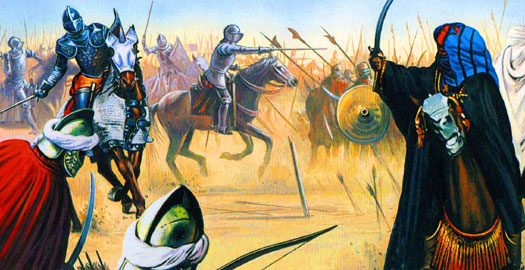 The Christian conquest of Iberia was a drawn-out process which covered several centuries of combat and slow Christian advance, but in its later days it frequently spilled over into North African kingdoms which were supporting the 'Moors' in southern Iberia The Christian conquest of Iberia was a drawn-out process which covered several centuries of combat and slow Christian advance, but in its later days it frequently spilled over into North African kingdoms which were supporting the 'Moors' in southern Iberia |
|
| 1396 - 1398 |
Matthew |
Restored. Died without producing an heir. |
| 1398 |
Upon Matthew's death without his having produced a legitimate make heir, his estate and titles pass to Isabel (Isabella) or Elizabeth Castellbó, who is usually referred to as Isabel de Foix. She has already (in 1381) married Arquimbald de Grailly, lord of Grailly, but it takes the French king four years to recognise his role as count of Foix because he is allied to the English. |
|
| Bishops of Urgel |
Lords of Grailly |
|
| 1398 - 1413 |
Isabella |
Sister. Countess of Foix, and viscountess of Castellbò. |
| 1398 - 1413 |
Archibald / Arquimbald |
Husband and joint prince of Andorra with Isabella. |
| 1408 - 1409 |
William III of Narbonne lands on Sardinia on 8 December 1408 to be crowned king, but Martin the Humane's son, Martin the Younger, has already landed a force of his own from Sicily (on 6 October), with a subsidiary force of men under the command of John, son of Arquimbald and Isabella. The two meet at the Battle of Sanluri in 1409 and the battle is a disaster for William. He is forced to flee to France for assistance, but Martin of Sicily dies of malaria a few days after the battle. |
|
| 1413 - 1426 |
With the death of Arquimbald, Isabella hands everyday administrative duties to their son, John. The countess remains nominally in overall authority until her own death in 1426. In 1415, Henry V of England wins a surprise victory at the Battle of Agincourt. One of the relatively small number of commanders to survive on the French side is John I, count of Foix. 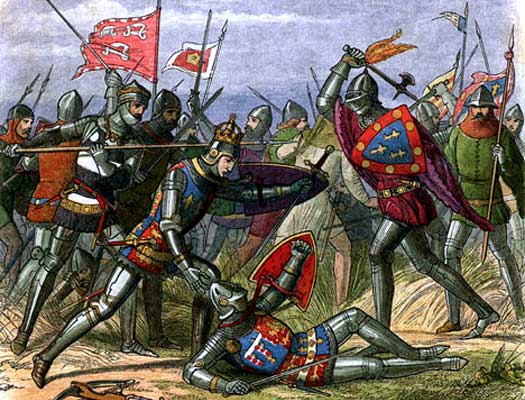 The overwhelming victory for the forces of Henry V at the Battle of Agincourt destroyed the flower of French chivalry and gave all of France to a Plantagenet king The overwhelming victory for the forces of Henry V at the Battle of Agincourt destroyed the flower of French chivalry and gave all of France to a Plantagenet king |
|
| Five years later, Charles VI cedes France to Henry V in the Treaty of Troyes. The king's son, Charles VII, apparently dispossessed, refuses to heed his father's commands and sets up a rival claim to the throne, accompanied by John of Foix. |
|
|
| 1413 - 1436 |
John I |
Son. Prince John of Foix, count of Foix, viscount of Bearn. |
| 1416 - 1436 |
Francesc de Tovia |
Bishop of Urgel. |
| 1422 - 1429 |
France is rightfully ruled by the English king, Henry VI, through his regent who is based in Normandy and Paris. Charles VII is little more than a rebel until he is crowned king of France in 1429 following his first meeting with Joan of Arc and the near-miraculous liberation of Orleans from an English siege. Charles' illegal claim suddenly becomes a serious one, and his kingship more and more real as the tide turns in favour of the French. |
|
| 1429 |
The Hundred Years War is over, with Charles VIII now king of France by right of conquest, if not by any other legal right. Aquitaine is returned to the king to rule directly as part of a newly united France. It also remains the direct possession of his successors. |
|
| 1436 - 1472 |
Gaston IV |
Son of John. Count of Foix. m Eleanore, infanta of Aragon. |
| 1437 - 1461 |
Arnau Roger de Pallars |
Bishop of Urgel. |
| 1462 - 1466 |
Jaume de Cardona |
Bishop of Urgel. |
| 1467 - 1472 |
Roderic de Borja |
Pope Alexander VI in 1492. |
| 1471 - 1472 |
Louis XI of France refuses to recognise the rights of the Foix in Navarre, and Gaston teams up with his new son-in-law, Francis II of Brittany (who has just married Princess Margarita of Foix in the same year), and also Charles the Bold of Burgundy, and revolts. 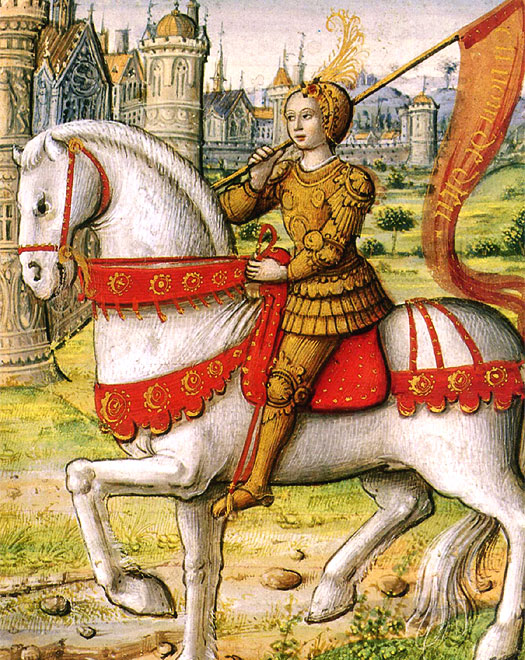 Joan of Arc began her fight against the English 'occupiers' of France as a freedom fighter who inspired others to follow her, but she ended as a pawn in political powerplays Joan of Arc began her fight against the English 'occupiers' of France as a freedom fighter who inspired others to follow her, but she ended as a pawn in political powerplays |
|
| However, he quickly dissolves the alliance and flees to Navarre where he heads the supporters of his wife, Eleanore. He dies at Roncesvalles in 1472. |
|
|
| 1472 - 1515 |
Pere de Cardona |
Bishop of Urgel. |
| 1472 - 1483 |
Francis Phoebus |
Grandson. Count of Foix. King of Navarre. Poisoned? |
| 1479 |
Eleanore is the daughter of Blanca and John II, king of Aragon. Married to Gaston IV, count of Foix and co-prince of Andorra, she is already a widow by now (with Gaston dying in 1472). Instead, their grandson, Francis Phoebus, succeeds as king of Navarre, and has already served as the count of Foix and co-prince of Andorra since 1472. (His father, Gaston of Foix, son of Gaston IV, had predeceased his father in 1470.) |
|
| 1483 - 1512 |
Catherine |
Sister. Countess of Foix. Queen. m John III of Navarre. |
| 1505 |
Germaine of Foix marries Ferdinand II, king of Aragon, Navarre and [Sicily](ItalySicily.htm#Aragons United), and soon to be the regent of Castile, thereby bringing the lordship of Andorra under Spanish rule. |
|
| 1512 - 1513 |
Most of the kingdom of Navarre is seized by Aragon and then Castile under Ferdinand of Navarre and then his son, Charles I of a united Spain. Pamplona is occupied, Upper Navarre is annexed, and the title of viscount of Castellbò is confiscated. For a brief period they also hold authority over Andorra. The remainder of Navarre - now termed [French Navarre](IberiaNavarre.htm#French Navarre) - is still held by Catherine and John II, as are the counties of Foix and Bigorra, and the viscounties of Bearn and Marsan. 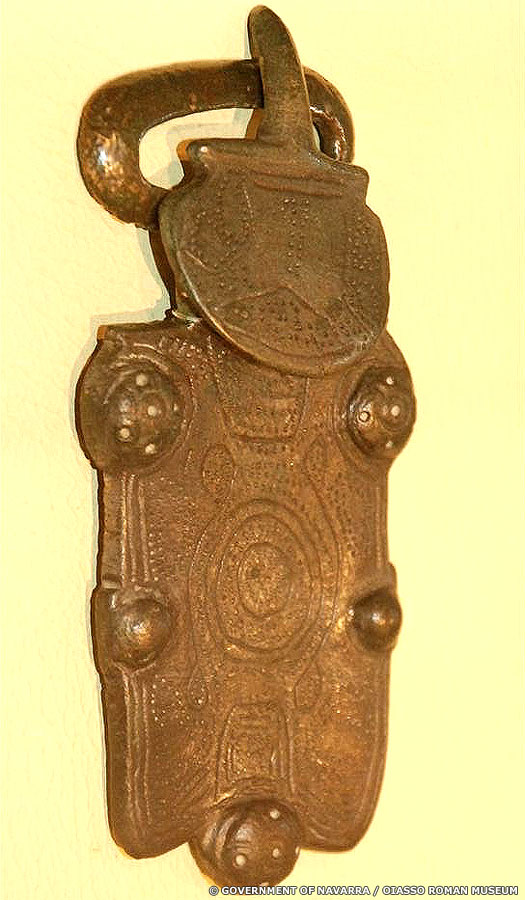 The Vascones port city of Oiasso (today's Irún) have revealed a surprising selection of grave goods from the period between the ending of Roman controls and the beginnings of the Basque kingdom of Navarre in the eighth century AD The Vascones port city of Oiasso (today's Irún) have revealed a surprising selection of grave goods from the period between the ending of Roman controls and the beginnings of the Basque kingdom of Navarre in the eighth century AD |
|
| Bishops of Urgel |
D'Albret |
|
| 1512 - 1517 |
Catherine |
Reduced to [French Navarre](IberiaNavarre.htm#French Navarre). Countess of Foix. |
| 1512 - 1516 |
John II |
Husband, and co-ruler of [French Navarre](IberiaNavarre.htm#French Navarre). |
| 1515 - 1530 |
Joan D'espés |
Bishop of Urgel. |
| 1516 |
On taking over the kingdoms of Castile, Navarre, and Aragon under the banner of a united Spain, Charles I of Habsburg grants the lordship of Les Valls ('The Valleys'), as it is currently known, in perpetuity to Germaine of Foix's line. |
|
| 1516 - 1555 |
Henry II |
Son of John. Co-ruler in [French Navarre](IberiaNavarre.htm#French Navarre) after father's death. |
| 1532 - 1533 |
Pere Jordan de Urries |
Bishop of Urgel. |
| 1534 - 1551 |
Francesc de Urries |
Bishop of Urgel. |
| 1552 - 1556 |
Miquel Despuig |
Bishop of Urgel. |
| 1555 - 1572 |
Jeanne III d'Albret |
Daughter of Henry. Queen of [Fr Navarre](IberiaNavarre.htm#French Navarre). Countess of Foix. |
| Bishops of Urgel |
House of Capet-Bourbon |
|
| 1555 - 1562 |
Anthony / Antoine |
Husband and co-ruler with Jeanne III. Duc de Vendome. |
| 1556 - 1560 |
Joan Pérez García de Olivan |
Bishop of Urgel. |
| 1561 - 1571 |
Pere de Castellet |
Bishop of Urgel. |
| 1560 - 1562 |
A massacre of Protestants by [Catholics](ItalyPopes.htm#Early Modern) near Paris in 1562 ignites the first of eight French Wars of Religion. Jeanne d'Albret and Anthony have already introduced reforms in [French Navarre](IberiaNavarre.htm#French Navarre) and Bearn in line with Jeanne's Calvinist beliefs. 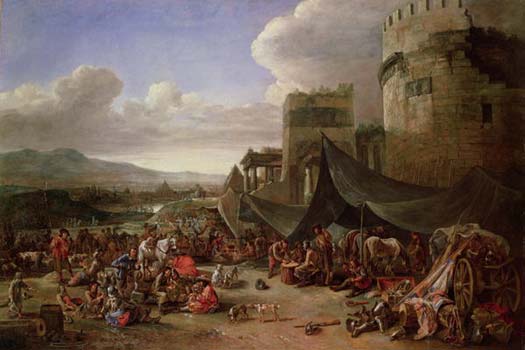 In the struggle for political domination in Europe the pope sided with France, with the result that the Habsburg army sacked Rome in 1527, as painted by Johannes Lingelbach In the struggle for political domination in Europe the pope sided with France, with the result that the Habsburg army sacked Rome in 1527, as painted by Johannes Lingelbach |
|
| Anthony's own brother, Louis I Bourbon, prince of Condé, had already been arrested and sentenced to death (in 1560) for supporting the Protestant cause. As the conflict begins, Anthony is in Rouen, where he is harried and where he dies on 10 November 1562. |
|
|
| 1562 - 1610 |
Henry III |
Son of Anthony. Duke of Bourbon. King of France (1589). |
| 1568 - 1571 |
The French king, Charles IX, orders the confiscation of the lands of his Protestant opponents. The [Catholics](ItalyPopes.htm#Early Modern) of Bearn, part of the holdings of Jeanne III, led by Terride, rebel and take power as royal troops do elsewhere. The peace of Longjumeau of 23 March 1568, ends the Second French War of Religion but almost immediately the Third French War of Religion begins in September 1568. The Battle of Jarnac on 12 March 1569 kills the prince of Condé, the Protestant leader, and Henry of [Navarre](IberiaNavarre.htm#French Navarre) is appointed the new political leader while military leadership is in the hands of Gaspard de Coligny. 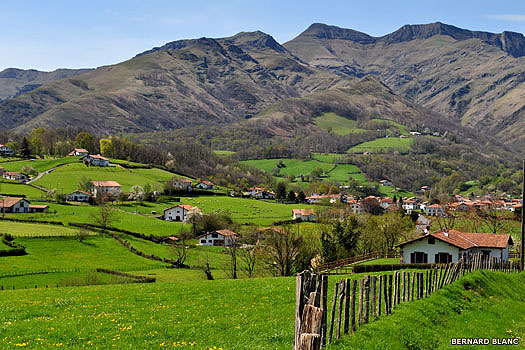 The poor lands of French Navarre were filled with small farms abutting the jagged hills of the Pyrenees, with most of the working population having Basque ancestry - linking them directly to the earliest hunter-gatherer settlers in Europe The poor lands of French Navarre were filled with small farms abutting the jagged hills of the Pyrenees, with most of the working population having Basque ancestry - linking them directly to the earliest hunter-gatherer settlers in Europe |
|
| In August 1569, Jeanne III regains her estates with the arrival of the forces of Duke Francis de Montmorency. On 8 August of 1570 the Peace of Saint-Germain-en-Laye is signed. In 1571 the status of Calvinism is formalised in Bearn and Navarre as the state religion, and shortly afterwards Jeanne negotiates a union between her son, Henry of Navarre, with Marguerite de Valois, sister of Charles IX of France, although she does not live to see the union effected. |
|
|
| 1572 - 1576 |
Joan Dimes Lloris |
Bishop of Urgel. |
| 1577 - 1579 |
Miquel Jeroni Morell |
Bishop of Urgel. |
| 1580 - 1586 |
Hug Ambròs de Montcada |
Bishop of Urgel. |
| 1587 - 1609 |
Andreu Capella |
Bishop of Urgel. |
| 1589 |
Henry III, king of France, recognises as his successor the Protestant Henry III, duc de Bourbon, king of[French Navarre](IberiaNavarre.htm#French Navarre), and co-prince of Andorra. The League of Cambrai and the duc de Guise are far from happy about this, but Henry has the duke of Guise assassinated at Blois. King Henry himself is stabbed to death on 2 August 1589 by the Dominican Jacques Clément. Henry of Navarre succeeds him as King Henry IV of (Bourbon) France. |
|
| 1589 - 1596 |
The League of Cambrai refuses to recognise Henry IV as king of France so he has to conquer his way to power. His conversion to [Catholicism](ItalyPopes.htm#Early Modern) at Saint-Denis (1589) followed by his coronation at Chatres (1594), opens Paris to him. His reconquest continues with the Edict of Nantes (1594) and the taking of Amiens (1596), which ends the civil wars. 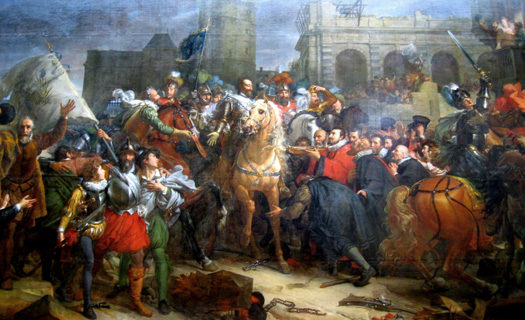 The entrance of Henry IV into Paris in 1594 as depicted in oils and which marked the victory of the Bourbons of French Navarre in their efforts to claim the throne The entrance of Henry IV into Paris in 1594 as depicted in oils and which marked the victory of the Bourbons of French Navarre in their efforts to claim the throne |
|
| 1607 |
By edict, Henry III of France, [French Navarre](IberiaNavarre.htm#French Navarre), and Foix, establishes the head of the French state, along with the bishop of Urgel, as co-princes of Andorra. |
|
| 1610 - 1620 |
Bernat de Salvà |
Bishop of Urgel. |
| 1610 - 1643 |
Louis XIII |
Son of Henry III. King of France (1610-1643). |
| 1610 - 1617 |
Louis XIII, aged just nine when he ascends the French throne, is at first excluded from power by his powerful mother who acts as regent. Her co-regent, Concini, is assassinated on Louis' orders in 1617. Further afield during this century, French piracy in the Caribbean, mainly targeted at wealthy Spanish ships and the colony of Hispaniola, becomes firmly established. |
|
| 1621 - 1627 |
Lluis Diez Aux de Armendáriz |
Bishop of Urgel. |
| 1627 - 1633 |
Antoni Pérez |
Bishop of Urgel. |
| 1634 - 1651 |
Pau Duran |
Bishop of Urgel. |
| 1643 - 1715 |
Louis XIV |
Son of Louis XIII. King of France (1643-1715). |
| 1643 - 1661 |
With Louis' agreement, Cardinal Mazarin (along with the king's mother) governs France until Mazarin's death in 1661, by which time the king is twenty-three. During his reign, Louis establishes an absolute monarchy, but is almost constantly at war internally, owing to the revolts of a people overburdened by taxation and opposition from princes of the blood, disappointed from being progressively excluded from power. 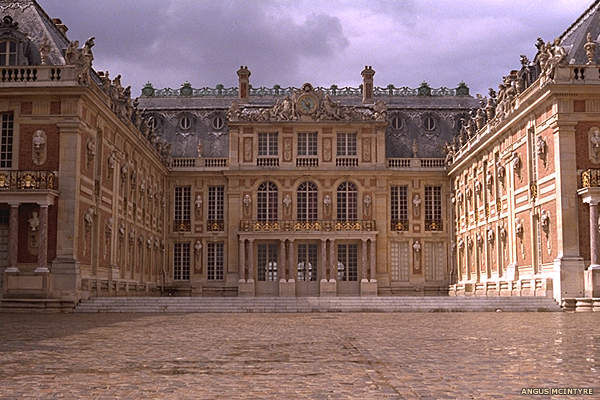 The Marble Court at the heart of the Palace of Versailles was formed out of the earlier pavilion, part of the original lodge of 1624 (click or tap on image to read more) The Marble Court at the heart of the Palace of Versailles was formed out of the earlier pavilion, part of the original lodge of 1624 (click or tap on image to read more) |
|
 This process is accelerated when the king removes his court to the newly-built Palace of Versailles, just outside Paris, where he is able to control the court and small council of the few faithful (see feature link). This process is accelerated when the king removes his court to the newly-built Palace of Versailles, just outside Paris, where he is able to control the court and small council of the few faithful (see feature link). |
|
|
| 1655 - 1663 |
Joan Manuel Espinosa |
Bishop of Urgel. |
| 1664 - 1670 |
Melcior Palau |
Bishop of Urgel. |
| 1671 - 1681 |
Pere de Copons |
Bishop of Urgel. |
| 1682 - 1688 |
Joan Baptista Desbac |
Bishop of Urgel. |
| 1689 - 1694 |
Oleguer de Montserrat |
Bishop of Urgel. |
| 1695 - 1714 |
Julián Cano y Tovar |
Bishop of Urgel. |
| 1702 - 1715 |
[Portugal](IberiaPortugal.htm#Kingdom of Braganza) initially supports France during the War of Spanish Succession, but Britain alters the situation with the signing of the Methuen Treaty with Portugal on 16 May 1703. In December 1703 a military alliance between [Austria](GermanyAustria.htm#Habsburg Archdukes), Britain, and Portugal sees them invade Spain. The allied forces capture Madrid in 1706, although the campaign ends in a defeat at the Battle of Almansa. The conclusion of the war in 1715 ensures that the Bourbon crowns of Spain and France can never be united under a single ruler. |
|
| 1714 - 1737 |
Simeón de Guinda y Apéztegui |
Bishop of Urgel. |
| 1715 - 1774 |
Louis XV |
Great-grandson of Louis XIV. King of France (1715-1774). |
| 1738 - 1747 |
Jorge Curado y Torreblanca |
Bishop of Urgel. |
| 1740 - 1748 |
The War of the Austrian Succession is a wide-ranging conflict which encompasses the North American King George's War, two Silesian Wars, the War of Jenkins' Ear, and involves most of the crowned heads of Europe in deciding the question of whether Maria Theresa can succeed as archduke of [Austria](GermanyAustria.htm#Habsburg Archdukes) and, perhaps even more importantly, as Holy Roman emperor. 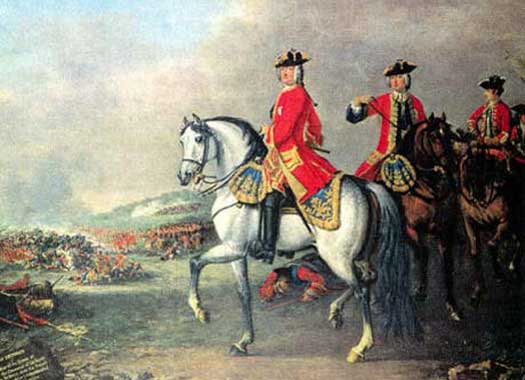 The War of the Austrian Succession saw Europe go to war to decide whether Maria Theresa would secure the throne left to her by her father, but several other issues were also decided as a wide range of wars were involved in the overall conflict The War of the Austrian Succession saw Europe go to war to decide whether Maria Theresa would secure the throne left to her by her father, but several other issues were also decided as a wide range of wars were involved in the overall conflict |
|
| Austria is supported by Britain, the [Netherlands](FranceHolland.htm#House of Orange), the Savoyard kingdom of Sardinia, and Saxony (after an early switchover), but opposed by an opportunistic Prussia and France, who had raised the question in the first place to disrupt Habsburg control of Central Europe, backed up by [ Bavaria](GermanyBavarians.htm#Duchy of Bavaria %28Wittelsbachs%29) and Sweden (briefly). Spain joins the war in an unsuccessful attempt to restore possessions which had been lost to Austria in 1715. |
|
|
| 1747 - 1756 |
Sebastián de Victoria de Emparán |
Bishop of Urgel. |
| 1757 - 1762 |
Francisco José Catalán de Ocón |
Bishop of Urgel. |
| 1763 - 1771 |
Francisco Fernández de Xátiva |
Bishop of Urgel. |
| 1772 - 1779 |
Joaquín de Santiyán y Valdivieso |
Bishop of Urgel. |
| 1774 - 1792 |
Louis XVI |
Grandson of Louis XV. King of France (1774-1792). |
| 1780 - 1783 |
Juan García Montenegro |
Bishop of Urgel. |
| 1785 - 1795 |
José de Boltas |
Bishop of Urgel. |
| 1789 - 1792 |
Louis XVI is unable to impose the reforms he wants in France and fails to support his more competent ministers. An economic crisis aggravated by the American War of Independence leads the government to convene the states general on 5 May 1789. Ill-advised and influenced by the queen, Louis leads the monarchy to its fall. 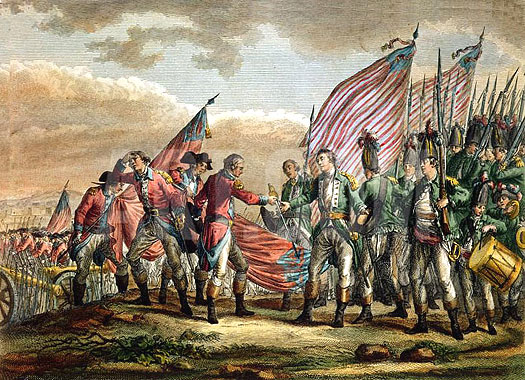 The Second Battle of Saratoga on 7 October in the American War of Independence saw the mixed British forces of about five thousand British, Brunswickers, Canadians, and Indians surrender to around 14,000 American militia and regular troops The Second Battle of Saratoga on 7 October in the American War of Independence saw the mixed British forces of about five thousand British, Brunswickers, Canadians, and Indians surrender to around 14,000 American militia and regular troops |
|
| The French Revolution begins on 14 July with the storming of the Bastille prison during a popular uprising in Paris. On 10 August 1792 the Tuileries is taken by the Paris mob, signalling the end of the Ancien Régime. The king is deposed and imprisoned in the Temple with his family, and is condemned to death by a narrow majority. |
|
|
| 1792 - 1795 |
Louis XVII |
Son of Louis XVI. Uncrowned king of France. |
| 1793 - 1794 |
The ex-king, Louis XVI, is executed by guillotine on 21 January, while his brother (the future Louis XVIII) has already fled the country. On 6 April, the Committee of Public Safety is created in Paris, headed by Maximilien Robespierre, and so begins 'The Terror'. In the same year, the [French](FranceFranks.htm#First Republic) revolutionary government refuses the traditional Andorran tribute because it smacks of feudalism. French suzerainty is renounced, despite the wish of the Andorrans to enjoy French protection and avoid being exclusively under Spanish influence. |
|
| 1795 - 1806 |
(Vacant) |
Position refused by the [French](FranceFranks.htm#First Republic) Directory. |
| 1797 - 1816 |
Francisco Antonio de la Dueña y Cisneros |
Bishop of Urgel. |
| 1798 - 1799 |
Following Napoleon's failed expedition to [ Egypt](../KingListsAfrica/EgyptIslamic.htm#Mameluke Subjects), the [French](FranceFranks.htm#First Republic) Directory is swept away by a coup on '18 Brumaire', 9 November. Although several members of the failing directory support the coup, one of its main instigators is Napoleon himself. He becomes the head of the new government as 'First Consul'. 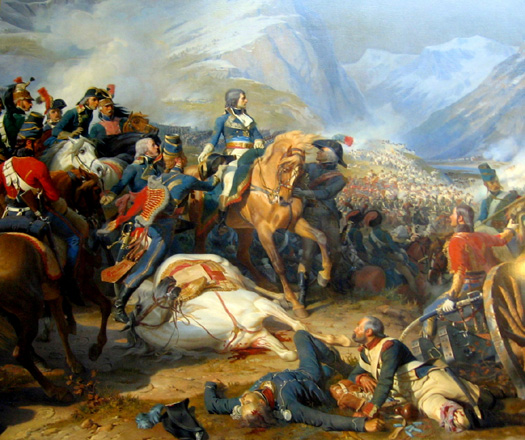 Napoleon commands at the Battle of Rivoli, 14-15 January 1797, the first French campaign in Italy against Austria, and the start of Bonaparte's highly successful command of the French forces in Italy Napoleon commands at the Battle of Rivoli, 14-15 January 1797, the first French campaign in Italy against Austria, and the start of Bonaparte's highly successful command of the French forces in Italy |
|
| 1804 - 1806 |
Napoleon Bonaparte gravitates France towards the creation of the [First Empire](FranceFranks.htm#First Empire), convinced that creating a new French monarchy and embedding it in the constitution will make a Bourbon restoration much harder. In 1806, he restores the co-principality after the Andorrans have petitioned him to do so. French title to the principality subsequently passes from the emperor and then kings to the presidents of France. |
|
| Bishops of Urgel |
House of Bonaparte |
|
| 1806 - 1814 |
Napoleon I Bonaparte |
Emperor of [France](FranceFranks.htm#First Empire) (1804-1814). |
| 1814 - 1806 |
Napoleon is defeated and abdicates the thrones of [France](FranceFranks.htm#First Empire) and Italy. The Bourbon monarchy is restored under Louis XVIII, and the czar of Russia, less antagonistic towards the former emperor than other European monarchs, helps in the choice of the Mediterranean island of Elba as a small kingdom to which Napoleon can retire. |
|
| Bishops of Urgel |
House of Capet-Bourbon |
|
| 1814 - 1815 |
Louis XVIII |
Brother of Louis XVI. King of France (1814-1815). |
| 1814 - 1815 |
Payments to Napoleon from France towards his upkeep, as promised by the victorious allies, never arrive because Louis XVIII blocks them. Eventually, in 1815, Napoleon abandons his exile for the Hundred Days rule, and Louis XVIII flees to Belgium. 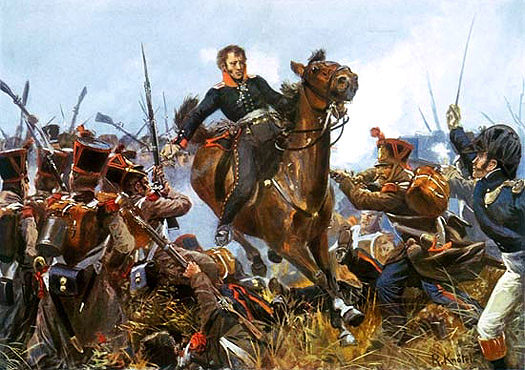 French grenadiers of the line defend against an attack by Prussian infantry in the three-day Battle of Leipzig in October 1813, dubbed the 'Battle of the Nations' due to the number of states involved, in this 1914 painting by Richard Knötel French grenadiers of the line defend against an attack by Prussian infantry in the three-day Battle of Leipzig in October 1813, dubbed the 'Battle of the Nations' due to the number of states involved, in this 1914 painting by Richard Knötel |
|
| Bishops of Urgel |
House of Bonaparte |
|
| 1815 |
Napoleon I Bonaparte |
Restored as emperor of [France](FranceFranks.htm#First Empire) (1815). |
| 1815 |
 Europe mobilises against France and the duke of Wellington's Anglo-[Dutch](FranceHolland.htm#Kingdom of Holland %28Orange%29)-German army defeats Napoleon at the Battle of Waterloo on 18 June in conjunction with the Prussian army, ending twenty-five years of war in Europe. The French monarchy is restored. Europe mobilises against France and the duke of Wellington's Anglo-[Dutch](FranceHolland.htm#Kingdom of Holland %28Orange%29)-German army defeats Napoleon at the Battle of Waterloo on 18 June in conjunction with the Prussian army, ending twenty-five years of war in Europe. The French monarchy is restored. |
|
| Bishops of Urgel |
House of Capet-Bourbon |
|
| 1815 - 1824 |
Louis XVIII |
Restored king of France (1815-1824). |
| 1817 - 1824 |
Bernardo Francés y Caballero |
Bishop of Urgel. |
| 1820 - 1823 |
King Ferdinand VII of Spain is detained by rebels after refusing to adopt the new and liberal Spanish Constitution of 1812. It takes until 1822 for European states to react and in 1823, under general agreement by those states, French forces invade Spain to restore Ferdinand, supported by Charles Albert, the future Savoyard king of Sardinia. The Battle of Trocadero sees the French attack a fort from the seaward side to secure access to Cadiz itself, which falls after a three week siege. Ferdinand is freed to take his revenge, executing around thirty thousand people. 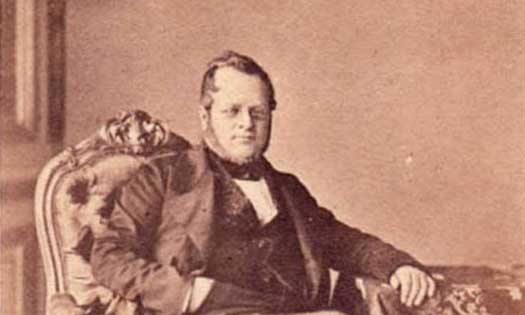 Count Camillo Benso di Cavour, Sardinia's new, liberal minister from 1852, was a leading figure in the move towards Italian unification, an aim which was achieved in 1861 after two years of war against Austria Count Camillo Benso di Cavour, Sardinia's new, liberal minister from 1852, was a leading figure in the move towards Italian unification, an aim which was achieved in 1861 after two years of war against Austria |
|
| 1824 - 1827 |
Bonifacio López y Pulido |
Bishop of Urgel. |
| 1824 - 1830 |
Charles X |
Brother of Louis XVIII. King of France. Deposed. Died 1836. |
| 1827 - 1851 |
Simón de Guardiola y Hortoneda |
Bishop of Urgel. |
| Bishops of Urgel |
House of Capet-Bourbon-Orleans |
|
| 1830 - 1848 |
Louis Philippe |
Duc de Orleans. King of France (1830-1848). |
| 1847 - 1848 |
An economic crisis in 1847 is the final straw for the working classes in France, after a steady worsening in their general conditions under the king's rule. In a year of European revolutions in 1848 (Galicia, [ Hessen-Darmstadt](GermanyHessenDarmstadt.htm#Grand Dukes), Ireland, Liechtenstein, [Lombardy-Ventia](ItalyKingdom.htm#Austria Restored), and [Wallachia](EasternWallachia.htm#Tax Farmer) also experience problems), they revolt against the government and the monarchy is overthrown. Louis Philippe abdicates in favour of his grandson and flees to Britain, mindful of the fate of Louis XVI in 1793. Public opinion is against his grandson being crowned, so on 26 February the French '[Second Republic](FranceFranks.htm#Second Republic)' is declared. 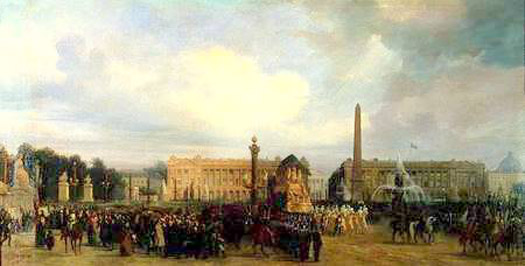 The return of Napoleon's ashes in 1840 in a painting by Jacques Guiaud, with the funeral cortege entering the Place de la Concorde The return of Napoleon's ashes in 1840 in a painting by Jacques Guiaud, with the funeral cortege entering the Place de la Concorde |
|
| Bishops of Urgel |
House of Bonaparte |
|
| 1848 - 1871 |
Louis Napoleon III |
President, and then emperor of [France](FranceFranks.htm#Second Empire) (1852-1871). |
| 1852 |
Prince Louis Napoleon Bonaparte, who has been president of [France](FranceFranks.htm#Second Republic) since December 1848, now declares himself emperor. The republic is replaced by the '[Second Empire](FranceFranks.htm#Second Empire)'. Louis Napoleon III is a member of the House of Napoleon Bonaparte so, initially, the crowned heads of Europe watch him nervously, worried that he may resume the empire-building ambitions of his uncle. |
|
| 1853 - 1879 |
José Caixal y Estrada |
Bishop of Urgel. |
| 1870 - 1871 |
Napoleon III refuses to accept the possibility of the Prussian Prince Leopold of Hohenzollern-Sigmaringen gaining the Spanish throne, and ends up personally insulting the king of Prussia. The disagreement leads to [France](FranceFranks.htm#Second Republic) going to war against Prussia, but the country is humiliated with defeat and an invasion by Prussia's armies, leading to the siege of Paris. The empire collapses and Louis Napoleon goes into exile in England where he later dies and is buried. |
|
| Bishops of Urgel |
French Republic |
|
| 1871 |
 A series of republics replaces any further attempts at forming a French monarchy or empire. The French 'Third Republic' is formed in 1871, although it almost founders with the crushing of the Paris Commune and the majority decision to select a new king. Henri, count of Chambord and former duke of Bordeaux, who had been unconfirmed king for eleven days in 1830, refuses to acknowledge the tricolour as the national flag of France and the restoration is effectively sabotaged. A series of republics replaces any further attempts at forming a French monarchy or empire. The French 'Third Republic' is formed in 1871, although it almost founders with the crushing of the Paris Commune and the majority decision to select a new king. Henri, count of Chambord and former duke of Bordeaux, who had been unconfirmed king for eleven days in 1830, refuses to acknowledge the tricolour as the national flag of France and the restoration is effectively sabotaged. 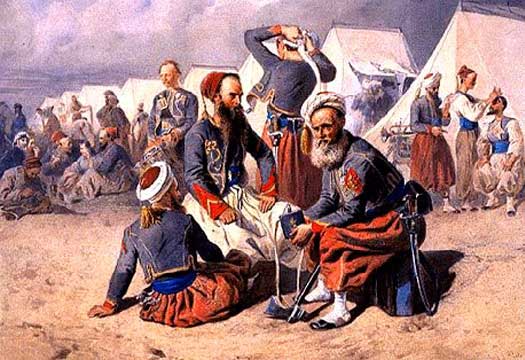 This illustration of French Zouaves (light infantry, generally drawn from North Africa) in Crimea was published in The Charleston Mercury on 21 November 1861 This illustration of French Zouaves (light infantry, generally drawn from North Africa) in Crimea was published in The Charleston Mercury on 21 November 1861 |
|
| 1871 - 1873 |
Louis Adolphe Thiers |
President of France. |
| 1873 - 1879 |
Patrice M de MacMahon |
President of France. |
| 1879 - 1887 |
Francois P J Grévy |
President of France. |
| 1879 - 1901 |
Salvador Casanas y Pagés |
Bishop of Urgel. |
| 1887 - 1894 |
Marie Sadi Carnot |
President of France. |
| 1894 - 1895 |
Jean Casimir Périer |
President of France. |
| 1895 - 1899 |
Francois Félix Faure |
President of France. |
| 1899 - 1906 |
Émile Loubet |
President of France. |
| 1901 |
Ramón Riu y Cabanes |
Bishop of Urgel. |
| 1905 - 1906 |
Juan José Laguarda y Fonollera |
Bishop of Urgel. |
| 1906 - 1913 |
Juan Benlloch y Vivó |
Bishop of Urgel. |
| 1906 - 1919 |
Clement Armand Fallieres |
President of France. |
| 1913 - 1920 |
Raymond Poincaré |
President of France. |
| 1914 - 1918 |
Having jointly guaranteed in 1839 to support the neutrality of Belgium, when the country is invaded by Germany, Britain, France, and Russia are forced to declare war at midnight on 4 August 1914. 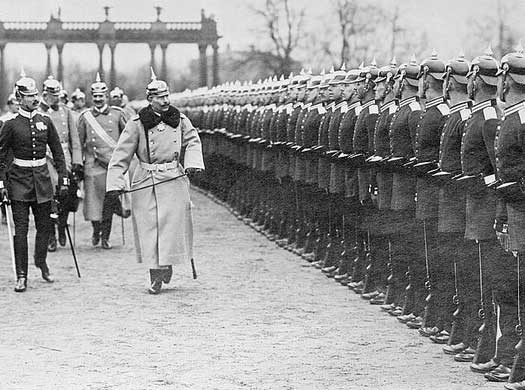 Kaiser Wilhelm II of Prussia and the German empire inspects his troops on the eve of war in 1914, a war which none of the tributary German principalities had any chance of escaping Kaiser Wilhelm II of Prussia and the German empire inspects his troops on the eve of war in 1914, a war which none of the tributary German principalities had any chance of escaping |
|
| The German armies head towards Paris before being halted and retreating to what becomes the Western Front just inside French territory. A ceasefire is agreed with the remnants of the [ Austro-Hungarian](GermanyAustria.htm#Habsburg Emperors) empire by British, French, and Italian forces on 3 November 1918, effectively ending the First World War. |
|
|
| 1920 - 1940 |
Justino Guitart y Vilardebó |
Bishop of Urgel. |
| 1920 |
Paul E L Deschanel |
President of France. |
| 1920 - 1924 |
Alexandre Millerand |
President of France. |
| 1924 - 1931 |
Gaston Doumergue |
President of France. |
| 1931 - 1932 |
Paul Doumer |
President of France. |
| 1932 - 1940 |
Albert Lebrun |
President of France. |
| Skossyrev / Skossyreff |
Vichy (Fascist) |
|
| 1934 |
Boris I |
Usurper. Ruled for a few days. |
| 1934 |
 Boris Skossyrev is an adventurer who proclaims himself king of Andorra, regent for the 'king of France', Jean d'Orléans, duc de Guise (heir presumptive to the throne of France), 'true count of Foix and Berne', ancient princes of Andorra. After a reign of eight days he is deposed by the bishop of Urgel and the French president, and is arrested and deported soon afterwards (see feature link for the full story). Boris Skossyrev is an adventurer who proclaims himself king of Andorra, regent for the 'king of France', Jean d'Orléans, duc de Guise (heir presumptive to the throne of France), 'true count of Foix and Berne', ancient princes of Andorra. After a reign of eight days he is deposed by the bishop of Urgel and the French president, and is arrested and deported soon afterwards (see feature link for the full story).  A cropped photograph of Boris Skossyreff in 1934,when he was certainly at his most active, having recently declared himself king of Andorra after providing 'services' to the Netherlands and operating a business in Colombia - his monocle is just about visible A cropped photograph of Boris Skossyreff in 1934,when he was certainly at his most active, having recently declared himself king of Andorra after providing 'services' to the Netherlands and operating a business in Colombia - his monocle is just about visible |
|
| 1939 - 1944 |
The Nazi German invasion of Poland on 1 September 1939 is the trigger for the Second World War. With both France and Britain pledged to support Poland, both countries have no option but to declare war on 3 September. After a lightening march through the [ Netherlands](FranceHolland.htm#Kingdom of Holland %28Orange%29) and Belgium, France is occupied by the Nazi war machine in 1940, ending the 'Third Republic'. Vichy (Fascist) rule is allowed as a puppet state in southern France (and Algeria). |
|
| 1940 - 1944 |
Henri Philippe Pétain |
President of France. |
| 1942 - 1969 |
Ramón Iglesias Navarri |
Bishop of Urgel. |
| 1944 |
A provisional government is established in France following the liberation of Paris on 25 August 1944. Marshal Henri Philippe Pétain, hero of Verdun in the First World War, is condemned to death for his part in appeasing the Nazis, but his sentences is commuted to life imprisonment. |
|
| Bishops of Urgel |
French Provisional Government |
|
| 1944 - 1946 |
Charles de Gaulle |
Chairman of the provisional government of France. |
| 1946 |
Félix Gouin |
Chairman of the provisional government of France. |
| 1946 - 1947 |
Georges Bidault |
Chairman of the provisional government of France. |
| 1944 - 1947 |
The 'Fourth Republic' is declared in France, almost as a continuation of the 'Third Republic' before it. Unfortunately it is eventually discredited by inflation and colonial defeats. 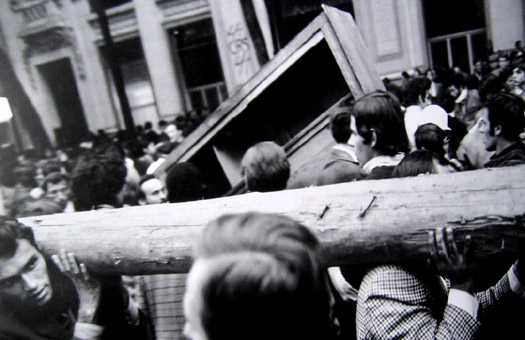 The spring of revolution in Paris in 1968 brought social change to France as a whole, as did a similar revolutionary spirit across much of the western world The spring of revolution in Paris in 1968 brought social change to France as a whole, as did a similar revolutionary spirit across much of the western world |
|
| Bishops of Urgel |
French Republic |
|
| 1947 - 1954 |
Vincent Auriol |
President of France. |
| 1954 - 1959 |
René Coty |
President of France. |
| 1959 - 1969 |
Charles de Gaulle |
President of France. |
| 1960s - 1980s |
Long an impoverished land with little contact with any nations other than the adjoining France and [Spain](IberiaSpain.htm#Juan Carlos), following the conclusion of the Second World War, Andorra achieves considerable prosperity through a developing tourist industry. This development is assisted by improvements in transport and communications. It serves to break down Andorra's isolation and to bring Andorrans into the mainstream of European history. Public demands for democratic reforms lead to the extension of the franchise to women in the 1970s and to the creation of new and more fully autonomous organs of government in the early 1980s. |
|
| 1969 - 1971 |
Ramón Malla Call |
Bishop of Urgel. |
| 1969 - 1974 |
Georges Pompidou |
President of France. |
| 1971 - 2003 |
Juan Marti Alanis |
Bishop of Urgel. |
| 1974 - 1981 |
Valéry Giscard d'Estaing |
President of France. |
| 1981 - 1995 |
Francois Mitterrand |
President of France. |
| 1991 - 1993 |
Andorra enters into a customs union with the European Communities (latterly the European Union) and is admitted to the United Nations on 28 July 1993. The country has long been seeking ways of improving its export potential and increase its economic ties with its European neighbours. The economy's financial services sector is highly important, given Andorra's status as a tax haven and its banking secrecy laws. 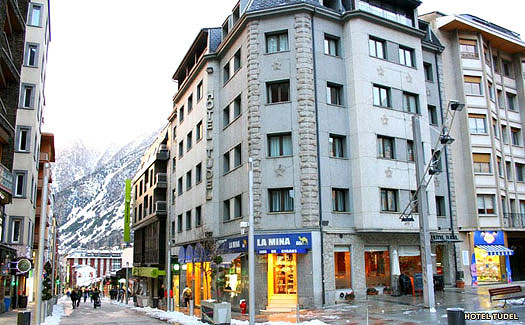 Modern Andorra quickly became a typical Western European location, but one which retained the stunning scenery of some of the highest levels of the Pyrenees Modern Andorra quickly became a typical Western European location, but one which retained the stunning scenery of some of the highest levels of the Pyrenees |
|
| 1993 |
Bishop Juan Marti Alanis of Urgel and President Francois Mitterrand of France are co-signatories of Andorra's new constitution. The principality finally becomes a parliamentary democracy. The new constitution retains the French and [Spanish](IberiaSpain.htm#Juan Carlos) co-princes, albeit with reduced, and narrowly defined powers. Civil rights are greatly expanded to include the legalisation of political parties and trade unions, and provision is made for an independent judiciary. |
|
| 1995 - 2007 |
Jacques Chirac |
President of France. |
| 2003 - On |
Joan Enric Vives Sicilia |
Bishop of Urgel. Elevated to archbishop as a personal title. |
| 2007 - 2012 |
Nicolas Sarkozy |
President of France. |
| 2009 |
President Nicolas Sarkozy of France threatens to abdicate as co-prince if the principality does not change its secretive banking laws to eliminate its longstanding status as a tax haven. Under considerable international pressure, Andorra announces that it will lift its banking secrecy in cases in which accords apply in regard to the interchange of tax data, promising a law by November 2009. 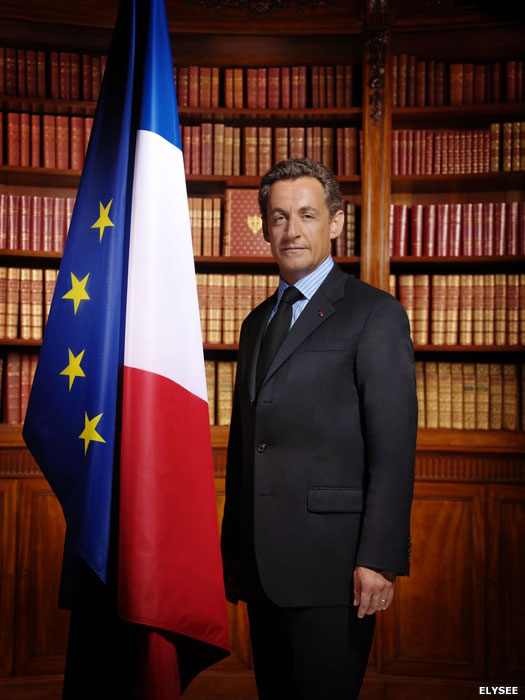 Previously the minister for 'Interior and Regional Development' between 2005-2007, Nicolas Sarkozy was elected president of the French republic on 6 May 2007 after winning 53.06% of the vote Previously the minister for 'Interior and Regional Development' between 2005-2007, Nicolas Sarkozy was elected president of the French republic on 6 May 2007 after winning 53.06% of the vote |
|
| 2012 - 2017 |
François Hollande |
President of France. |
| 2014 |
Joan Enric Vives i Sicília, bishop of Urgel, states that he will abdicate his position as co-prince of Andorra if the Andorran parliament passes a law which legalises abortion. The bishopric will then be held in abeyance at least until the law has been promulgated, so that no cleric will have to sign it. This would make Andorra the second country (after Belgium) in which a head of state has refused to sign a law which legalises the voluntary interruption of a pregnancy without actually preventing the law from being promulgated. |
|
| 2017 - On |
Emmanuel Macron |
President of France. |
 |
|
|
 Please note that the History Files does not regularly monitor changes in modern heads of state or their representatives. Get in touch here if this section requires updating.
Please note that the History Files does not regularly monitor changes in modern heads of state or their representatives. Get in touch here if this section requires updating.
 Andorra's mountainous landscape offers a very mixed selection of terrain, from lush valleys to high Pyrenean peaks and the Circ del Pessons shown here, a natural amphitheatre in the area of Grau Roig
Andorra's mountainous landscape offers a very mixed selection of terrain, from lush valleys to high Pyrenean peaks and the Circ del Pessons shown here, a natural amphitheatre in the area of Grau Roig Founded as the Roman colony of Barcino, between 15-10 BC by Emperor Augustus, the city of Barcelona became central to the medieval county of Barcelona and resistance against the Islamic invasion of Iberia
Founded as the Roman colony of Barcino, between 15-10 BC by Emperor Augustus, the city of Barcelona became central to the medieval county of Barcelona and resistance against the Islamic invasion of Iberia King Louis 'the Pious' of the Frankish empire attempted to leave the empire intact for his eldest son, Lothar, but the others rebelled at the idea. The treaty of Verdun in AD 843 confirmed the official division of the empire between Charlemagne's three surviving grandsons (click or tap on map to view full sized)
King Louis 'the Pious' of the Frankish empire attempted to leave the empire intact for his eldest son, Lothar, but the others rebelled at the idea. The treaty of Verdun in AD 843 confirmed the official division of the empire between Charlemagne's three surviving grandsons (click or tap on map to view full sized) Limoges remained the capital of the duchy of Aquitaine, and the Roman Catholic Cathedral of Saint-Etienne remained the city's religious seat
Limoges remained the capital of the duchy of Aquitaine, and the Roman Catholic Cathedral of Saint-Etienne remained the city's religious seat The bishopric of Urgel gained a diocesan seat in 1116, in the form of the Cathedral of Santa Maria d'Urgel, in Seu d'Urgel, although the diocese itself existed at least as early as the sixth century AD
The bishopric of Urgel gained a diocesan seat in 1116, in the form of the Cathedral of Santa Maria d'Urgel, in Seu d'Urgel, although the diocese itself existed at least as early as the sixth century AD The great temple which is located at the foot of the tower which forms part of the ancient castle of Castellbò is of an uncertain age, supposedly with Roman origins
The great temple which is located at the foot of the tower which forms part of the ancient castle of Castellbò is of an uncertain age, supposedly with Roman origins A medieval map of the city of Paris in the tenth century AD, under the rule of Hugh Capet. By this time Paris had declined from its two periods of greatness under the Romans and the Merovingians, but the map clearly shows the importance of the island at the city's heart
A medieval map of the city of Paris in the tenth century AD, under the rule of Hugh Capet. By this time Paris had declined from its two periods of greatness under the Romans and the Merovingians, but the map clearly shows the importance of the island at the city's heart The county of Foix was situated in south-eastern France, touching the Pyrenees at its lowest point and providing a western neighbour to the important regional centre of Narbonne
The county of Foix was situated in south-eastern France, touching the Pyrenees at its lowest point and providing a western neighbour to the important regional centre of Narbonne The Christian conquest of Iberia was a drawn-out process which covered several centuries of combat and slow Christian advance, but in its later days it frequently spilled over into North African kingdoms which were supporting the 'Moors' in southern Iberia
The Christian conquest of Iberia was a drawn-out process which covered several centuries of combat and slow Christian advance, but in its later days it frequently spilled over into North African kingdoms which were supporting the 'Moors' in southern Iberia The overwhelming victory for the forces of Henry V at the Battle of Agincourt destroyed the flower of French chivalry and gave all of France to a Plantagenet king
The overwhelming victory for the forces of Henry V at the Battle of Agincourt destroyed the flower of French chivalry and gave all of France to a Plantagenet king Joan of Arc began her fight against the English 'occupiers' of France as a freedom fighter who inspired others to follow her, but she ended as a pawn in political powerplays
Joan of Arc began her fight against the English 'occupiers' of France as a freedom fighter who inspired others to follow her, but she ended as a pawn in political powerplays The Vascones port city of Oiasso (today's Irún) have revealed a surprising selection of grave goods from the period between the ending of Roman controls and the beginnings of the Basque kingdom of Navarre in the eighth century AD
The Vascones port city of Oiasso (today's Irún) have revealed a surprising selection of grave goods from the period between the ending of Roman controls and the beginnings of the Basque kingdom of Navarre in the eighth century AD In the struggle for political domination in Europe the pope sided with France, with the result that the Habsburg army sacked Rome in 1527, as painted by Johannes Lingelbach
In the struggle for political domination in Europe the pope sided with France, with the result that the Habsburg army sacked Rome in 1527, as painted by Johannes Lingelbach The poor lands of French Navarre were filled with small farms abutting the jagged hills of the Pyrenees, with most of the working population having Basque ancestry - linking them directly to the earliest hunter-gatherer settlers in Europe
The poor lands of French Navarre were filled with small farms abutting the jagged hills of the Pyrenees, with most of the working population having Basque ancestry - linking them directly to the earliest hunter-gatherer settlers in Europe The entrance of Henry IV into Paris in 1594 as depicted in oils and which marked the victory of the Bourbons of French Navarre in their efforts to claim the throne
The entrance of Henry IV into Paris in 1594 as depicted in oils and which marked the victory of the Bourbons of French Navarre in their efforts to claim the throne The Marble Court at the heart of the Palace of Versailles was formed out of the earlier pavilion, part of the original lodge of 1624 (click or tap on image to read more)
The Marble Court at the heart of the Palace of Versailles was formed out of the earlier pavilion, part of the original lodge of 1624 (click or tap on image to read more) This process is accelerated when the king removes his court to the newly-built Palace of Versailles, just outside Paris, where he is able to control the court and small council of the few faithful (see feature link).
This process is accelerated when the king removes his court to the newly-built Palace of Versailles, just outside Paris, where he is able to control the court and small council of the few faithful (see feature link). The War of the Austrian Succession saw Europe go to war to decide whether Maria Theresa would secure the throne left to her by her father, but several other issues were also decided as a wide range of wars were involved in the overall conflict
The War of the Austrian Succession saw Europe go to war to decide whether Maria Theresa would secure the throne left to her by her father, but several other issues were also decided as a wide range of wars were involved in the overall conflict The Second Battle of Saratoga on 7 October in the American War of Independence saw the mixed British forces of about five thousand British, Brunswickers, Canadians, and Indians surrender to around 14,000 American militia and regular troops
The Second Battle of Saratoga on 7 October in the American War of Independence saw the mixed British forces of about five thousand British, Brunswickers, Canadians, and Indians surrender to around 14,000 American militia and regular troops Napoleon commands at the Battle of Rivoli, 14-15 January 1797, the first French campaign in Italy against Austria, and the start of Bonaparte's highly successful command of the French forces in Italy
Napoleon commands at the Battle of Rivoli, 14-15 January 1797, the first French campaign in Italy against Austria, and the start of Bonaparte's highly successful command of the French forces in Italy French grenadiers of the line defend against an attack by Prussian infantry in the three-day Battle of Leipzig in October 1813, dubbed the 'Battle of the Nations' due to the number of states involved, in this 1914 painting by Richard Knötel
French grenadiers of the line defend against an attack by Prussian infantry in the three-day Battle of Leipzig in October 1813, dubbed the 'Battle of the Nations' due to the number of states involved, in this 1914 painting by Richard Knötel Europe mobilises against France and the duke of Wellington's Anglo-[Dutch](FranceHolland.htm#Kingdom of Holland %28Orange%29)-German army defeats Napoleon at the Battle of Waterloo on 18 June in conjunction with the Prussian army, ending twenty-five years of war in Europe. The French monarchy is restored.
Europe mobilises against France and the duke of Wellington's Anglo-[Dutch](FranceHolland.htm#Kingdom of Holland %28Orange%29)-German army defeats Napoleon at the Battle of Waterloo on 18 June in conjunction with the Prussian army, ending twenty-five years of war in Europe. The French monarchy is restored. Count Camillo Benso di Cavour, Sardinia's new, liberal minister from 1852, was a leading figure in the move towards Italian unification, an aim which was achieved in 1861 after two years of war against Austria
Count Camillo Benso di Cavour, Sardinia's new, liberal minister from 1852, was a leading figure in the move towards Italian unification, an aim which was achieved in 1861 after two years of war against Austria The return of Napoleon's ashes in 1840 in a painting by Jacques Guiaud, with the funeral cortege entering the Place de la Concorde
The return of Napoleon's ashes in 1840 in a painting by Jacques Guiaud, with the funeral cortege entering the Place de la Concorde A series of republics replaces any further attempts at forming a French monarchy or empire. The French 'Third Republic' is formed in 1871, although it almost founders with the crushing of the Paris Commune and the majority decision to select a new king. Henri, count of Chambord and former duke of Bordeaux, who had been unconfirmed king for eleven days in 1830, refuses to acknowledge the tricolour as the national flag of France and the restoration is effectively sabotaged.
A series of republics replaces any further attempts at forming a French monarchy or empire. The French 'Third Republic' is formed in 1871, although it almost founders with the crushing of the Paris Commune and the majority decision to select a new king. Henri, count of Chambord and former duke of Bordeaux, who had been unconfirmed king for eleven days in 1830, refuses to acknowledge the tricolour as the national flag of France and the restoration is effectively sabotaged.  This illustration of French Zouaves (light infantry, generally drawn from North Africa) in Crimea was published in The Charleston Mercury on 21 November 1861
This illustration of French Zouaves (light infantry, generally drawn from North Africa) in Crimea was published in The Charleston Mercury on 21 November 1861 Kaiser Wilhelm II of Prussia and the German empire inspects his troops on the eve of war in 1914, a war which none of the tributary German principalities had any chance of escaping
Kaiser Wilhelm II of Prussia and the German empire inspects his troops on the eve of war in 1914, a war which none of the tributary German principalities had any chance of escaping Boris Skossyrev is an adventurer who proclaims himself king of Andorra, regent for the 'king of France', Jean d'Orléans, duc de Guise (heir presumptive to the throne of France), 'true count of Foix and Berne', ancient princes of Andorra. After a reign of eight days he is deposed by the bishop of Urgel and the French president, and is arrested and deported soon afterwards (see feature link for the full story).
Boris Skossyrev is an adventurer who proclaims himself king of Andorra, regent for the 'king of France', Jean d'Orléans, duc de Guise (heir presumptive to the throne of France), 'true count of Foix and Berne', ancient princes of Andorra. After a reign of eight days he is deposed by the bishop of Urgel and the French president, and is arrested and deported soon afterwards (see feature link for the full story).  A cropped photograph of Boris Skossyreff in 1934,when he was certainly at his most active, having recently declared himself king of Andorra after providing 'services' to the Netherlands and operating a business in Colombia - his monocle is just about visible
A cropped photograph of Boris Skossyreff in 1934,when he was certainly at his most active, having recently declared himself king of Andorra after providing 'services' to the Netherlands and operating a business in Colombia - his monocle is just about visible The spring of revolution in Paris in 1968 brought social change to France as a whole, as did a similar revolutionary spirit across much of the western world
The spring of revolution in Paris in 1968 brought social change to France as a whole, as did a similar revolutionary spirit across much of the western world Modern Andorra quickly became a typical Western European location, but one which retained the stunning scenery of some of the highest levels of the Pyrenees
Modern Andorra quickly became a typical Western European location, but one which retained the stunning scenery of some of the highest levels of the Pyrenees Previously the minister for 'Interior and Regional Development' between 2005-2007, Nicolas Sarkozy was elected president of the French republic on 6 May 2007 after winning 53.06% of the vote
Previously the minister for 'Interior and Regional Development' between 2005-2007, Nicolas Sarkozy was elected president of the French republic on 6 May 2007 after winning 53.06% of the vote